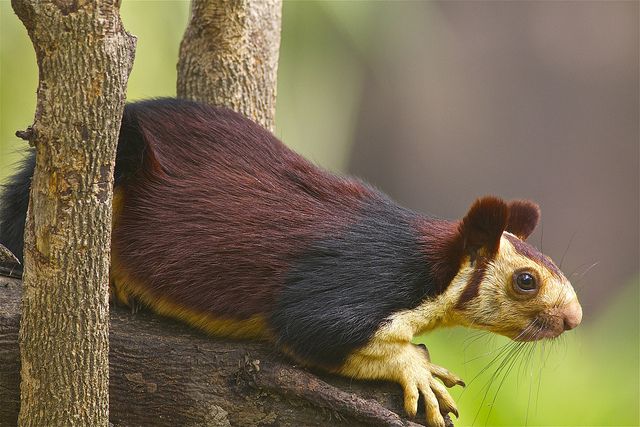Our protected areas network which is contiguous with the majestic Western Ghats are a buffer that absorbs the ills of our expanding urban spaces

As I grow older, in the unfathomable depth of my brain there is a forest of my childhood teeming with wildlife, where trees are still tall green and do not fear the axe, chirping birds soar high and far in the skies that are not obliterated by tall buildings and telecom towers, delicate butterflies flutter between wildflowers sipping nectar, free of pesticides. And that ‘little me’ is mesmerized with this unadulterated diversity and serenity of nature.
Fast forward to date, our green forests are fast disappearing and changing into grey concrete to accommodate plush and palatial bungalows of the arrogant ‘conquerors from Delhi’, our wildlife is flushed out of forests to accommodate roads, rails and power transmission lines, constitutional custodians are working hard in connivance with ‘compromised and convenient men of science’ (perhaps with better understanding of political science) to further ‘simplify the ‘ease of business’ in a state with fragile ecology.
And like many Goans who have not yet severed their umbilical cord from this soil, I find myself cynical, confused, tired and scared of the scenario that has emerged; that of Goa with all its greenery gone, its unique cultural identity adulterated and contaminated in the guise of mainstreaming, falsehood of development and bait of progress.
Fortunately, some few pockets of pristine greenery that are inviolate under law are our six wildlife sanctuaries and the lone national park. In fact, for a small state like ours, our protected areas network which is contiguous with the majestic Western Ghats are a buffer that absorbs the ills of our expanding urban spaces and offer habitat to a bewildering variety of wildlife.
However, the greatest threat to their sanctity is the greed to convert these natural areas into ‘cash cows’ through illegal mining, or ushering in capital intensive resort tourism that hardly benefits the local community. Overriding scientific opinions, consistent denials of presence of ‘keystone species’ like the tiger by key state stakeholders only point to nefarious intentions of weakening the protected status of such areas and opening them for lucrative commercial enterprise.
Sensitized public can be a dampener for this purported onslaught on our wilderness. But at the same time an ignorant citizenry can be the cause of misplaced activism. A couple of days ago, a video clip of a lion pride assumedly moving in the Verna industrial area went viral across the cyberspace of the state. Even the learned (including some fraternity colleagues) uploaded this video in their status stories adding to the panic, not aware that the Asiatic Lion is restricted only to Saurashtra peninsula of Gujarat!
Recently, I accompanied my students of Zoology to Bondla Wildlife Sanctuary for a field trip, after a long hiatus. Bondla, has not changed much with respect to facilities and visitor experience, unsatisfactory on both the counts. The entry gate is manned by staff who clearly lack soft skills and a sense of pride that they are guarding our state’s pristine wilderness.
The first wild animal to greet the visitor are restless troops of bonnet monkeys begging for food and drinks. They stealthily pilfer the edibles from the bags and vehicles and enjoy it. The langurs are curious but not friendly, they perch high up on the branches and keep an eye. While I was lecturing on ‘Goa’s wildlife and challenges it faces from us, the ‘political animals’ (I am not using this word as a backhand compliment or a cynical put-down, but exactly what Aristotle meant it to be, competitive and manipulative), sitting on a bench under a tree with a large canopy with my students all around me, I saw about 12 of these black faced simians observing me silently perched on the branches above. Perhaps they were astonished that they still matter to someone!
The ‘Nature Interpretation Centre’ was under repairs and renovation, and in absence of any guide or volunteers, I took my students on a guided tour of all captive enclosures sharing information on each species displayed. Intermittently, we could see free ranging giant Malabar squirrel foraging on fresh foliage, leaping through our state tree the ‘crocodile bark tree’. The spacious leopard enclosures with glass panels now offer a better view of the carnivore. It was a joy to watch a pack of golden jackals restlessly pacing up and down, visibly disturbed by our presence. The gaur herd was feeding off the fodder, monkeys boldly stealing mouthful from their feeding pans. The porcupines looked bored and cramped in their small enclosure but puffed and spread their armour of pointed black and white quills.
The section displaying snakes holds just about four species and does not evoke much interest. The signages all over the place were attractive and profusely illustrated with relevant information. The muggers were lazing as usual, and the wallowing wild boars camouflaged perfectly against the muck. Blackbuck, spotted deer and sambars have been relocated towards the gardens. The charismatic animals like lions and tigers do not survive here, probably they can’t endure the climate of our coastal state. Also, though many rescued wild animals are shifted here for treatment and care, the zoo does not have a fulltime wildlife veterinarian and hospital with necessary infrastructure. Despite the sincere efforts made by some upright officers, Bondla Zoo has been ignored for too long and is desperately awaiting modernization. There is no dearth of ideas nor funding, and the Central Zoo Authority compliances can be met if there is political will. After all, we live in a country where Asia’s richest man’s youngest son owns a ‘rescue and shelter facility’ (in reality a private zoo), where the rarest of the rare species of wildlife from India and abroad are held in captivity.